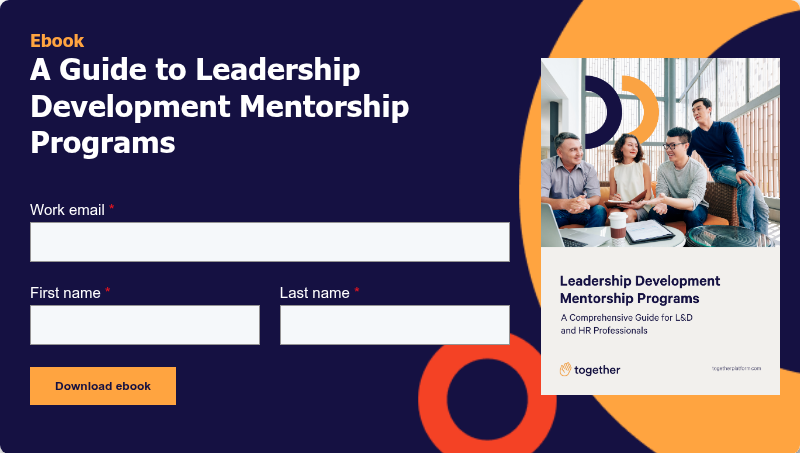"How do we know this mentorship program is actually working?"
It's the question that keeps L&D professionals awake at night and makes CFOs raise their eyebrows during budget reviews. You've invested time, money, and organizational energy into a leadership mentorship program. Participants seem engaged and share positive feedback. But when it comes to demonstrating concrete business impact, the evidence feels frustratingly anecdotal.
You're not alone in this challenge. According to LinkedIn's Workplace Learning Report, while 50% of upskilling and reskilling programs make it through the activation stage, only 4% reach the measurement stage. This means most leadership development programs fail before organizations can actually measure their effectiveness.
But here's the opportunity: organizations that master mentorship measurement don't just prove ROI—they create competitive advantages through data-driven program optimization and stakeholder confidence that fuels continued investment.
This guide will show you how to build measurement systems that demonstrate real business impact while providing actionable insights for continuous program improvement.
The multi-level measurement framework
Think of measuring mentorship impact like evaluating a great movie. You could just ask people if they liked it (satisfaction), but that doesn't tell you whether they learned something (skill development), changed their behavior afterward (application), or recommended it to others (business impact).
Effective mentorship measurement happens at multiple levels, from individual relationship health to organizational business impact. The most successful programs track both leading indicators—things that predict future success like relationship quality and goal completion—and lagging indicators that measure ultimate impact like promotions and retention.
Level 1: Reaction and satisfaction
The foundation of measurement starts with participant experience and engagement. While satisfaction scores alone don’t prove business value, they’re vital signs of program health. Track participant satisfaction and Net Promoter Scores (NPS), completion and retention rates, meeting frequency, engagement quality, and matching satisfaction. Use quarterly pulse surveys, focus groups, one-on-one interviews, and platform analytics to gather data. Strong programs achieve satisfaction scores above 4.0/5, completion rates over 85%, meetings meeting or exceeding guidelines, and NPS scores showing strong advocacy.
Level 2: Learning and skill development
This level measures whether participants are developing the leadership capabilities your program targets—the difference between feeling good about the program and actually growing. Track pre/post competency assessments, 360-degree feedback trends, goal achievement, milestone completion, and self-reported confidence. Use standardized assessments, feedback platforms with longitudinal tracking, goal monitoring systems, and skills demonstrations. Success means measurable competency gains, positive multi-rater feedback, 75%+ goal achievement, and increased leadership confidence.
Level 3: Behavior change and application
Level 3 measures whether participants apply their learning and change leadership behaviors. Track manager ratings, leadership behavior observations, team performance under mentee leadership, skill application, and peer feedback on collaboration and influence. Use manager assessments, team engagement metrics, peer evaluations, and case studies. Success is seen in observable behavior changes, improved team performance, confirmed applied learning, and peer recognition of leadership effectiveness.
Level 4: Business results and impact
The ultimate level measures organizational outcomes that prove mentorship’s business value. Track promotion rates, retention improvements, team performance, and leadership pipeline strength. Use HR analytics with control groups, performance and promotion data, team engagement and productivity metrics, and succession readiness assessments. Success means higher promotions, better retention for participants and their teams, improved team performance, and a stronger leadership pipeline.
Key Performance Indicators that actually matter
While comprehensive measurement includes multiple levels, focus on KPIs that provide clear insights into program health and business impact. Don't try to measure everything—you'll drown in data and lose sight of what actually matters.
Relationship health metrics
Strong mentoring relationships are the foundation of program success. Track indicators that predict relationship quality and sustainability. Meeting consistency and engagement matter more than you might think—percentage of pairs meeting monthly as scheduled, average meeting duration and frequency patterns, engagement quality scores from participant feedback, and relationship satisfaction ratings from both mentors and mentees.
Goal progress tells you whether relationships have direction and purpose. Monitor the percentage of pairs with documented development goals, goal achievement rates and milestone completion, regular goal review and adjustment frequency, and development plan quality and specificity scores.
Program impact metrics
These metrics demonstrate the broader organizational value of your mentorship investment. Leadership pipeline development shows whether you're building organizational capability—percentage of mentees promoted within 12-18 months, succession readiness improvements for key leadership roles, internal fill rates for leadership positions, and time-to-promotion reductions for program participants.
Talent retention and engagement metrics prove whether mentorship creates stickiness. Look at retention rate differences between participants and non-participants, employee engagement score improvements among participants, team retention rates under mentee leadership, and exit interview feedback related to development opportunities.
Business outcome metrics
Connect mentorship to bottom-line business results that executives care about. Team performance improvements include performance rating improvements for mentees and their teams, productivity metrics and goal achievement rates, customer satisfaction scores for teams led by participants, and innovation and improvement initiative leadership.
Cost savings and efficiency gains translate directly to financial impact through reduced external recruitment and hiring costs, decreased time-to-productivity for promoted participants, lower turnover-related costs among participants, and training and development cost efficiency improvements.
Calculating financial ROI
To justify continued investment and secure executive support, you need to demonstrate clear financial returns on your mentorship program investment. This is where the conversation shifts from "feels good" to "makes business sense."
The ROI calculation framework
Use this proven formula to calculate mentorship program ROI:
ROI = (Program Benefits - Program Costs) / Program Costs × 100
Identifying program benefits
Retention improvement benefits are often the biggest win. Calculate the value of reduced turnover among program participants by determining your average replacement cost per employee (typically $50,000-$75,000), retention rate improvement percentage comparing participants vs. non-participants, number of participants experiencing improved retention, then multiply: retention improvement percentage × number of participants × average replacement cost.
Productivity improvement benefits show the value of enhanced performance. Consider average participant salary and benefit costs, performance improvement percentage based on ratings or goal achievement, duration of improvement impact (typically 18-24 months), then calculate: performance improvement percentage × participant compensation × impact duration.
Promotion readiness benefits demonstrate accelerated leadership development through cost savings from internal vs. external leadership hiring, time-to-productivity improvements for promoted participants, succession planning risk reduction value, and leadership pipeline strength improvements.
Calculating program costs
Direct program costs include technology platform fees and implementation costs, training and development material expenses, program administration and facilitation time, and events, meetings, and resource material costs.
Don't forget participant time investment: average participant time investment for mentors and mentees, hourly compensation rates for time invested, opportunity cost of time spent in mentorship activities, and administrative time for program management and support.
Example ROI calculation
Let's look at a program with 100 participants (50 mentor-mentee pairs):
Benefits: Retention improvement of 20% reduction in turnover saves $500,000 (assuming $50,000 average replacement cost). Productivity gains of 15% improvement in performance equals $750,000 in value. Total benefits: $1,250,000.
Costs: Technology platform and administration costs $100,000. Training and development resources cost $50,000. Participant time investment costs $200,000. Total costs: $350,000.
ROI calculation: (1,250,000 - 350,000) ÷ 350,000 × 100 = 257% ROI
Now that's a number that gets executive attention.
Building effective measurement systems
Successful measurement requires systematic data collection, analysis, and reporting processes that provide actionable insights while minimizing administrative burden. Nobody wants to spend more time measuring than actually doing.
Data collection strategy
Automated data capture leverages technology to minimize manual data collection through platform analytics for engagement and activity tracking, integration with HRIS systems for promotion and retention data, calendar and communication tool integration for meeting tracking, and performance management system integration for goal and rating data.
Strategic survey design creates survey instruments that provide valuable insights without survey fatigue. Use quarterly pulse surveys with rotating focus areas, annual comprehensive program evaluation, exit surveys for program completers, and longitudinal follow-up surveys 6-12 months post-program.
Qualitative data collection balances quantitative metrics with qualitative insights through focus groups exploring participant experience depth, success story and case study development, interview-based outcome assessment, and peer and manager feedback collection.
Reporting and communication
Executive dashboard design creates high-level reporting that communicates key insights quickly. Include key metric trends and performance indicators, ROI calculation and business impact summary, success stories and participant highlights, and program health indicators and risk factors.
Stakeholder-specific reporting tailors measurement communication to different audience needs. Provide participant feedback and development progress reports, manager updates on team member participation and growth, executive summaries focusing on business impact and ROI, and board-level reporting emphasizing strategic value and competitive advantage.
Regular reporting cadence establishes consistent communication rhythms through monthly operational metrics and program health indicators, quarterly business impact and outcome reporting, annual comprehensive program evaluation and ROI analysis, and ad hoc reporting for specific stakeholder requests and decisions.
Continuous improvement integration
Data-driven program optimization uses measurement insights to continuously improve program effectiveness. Refine matching algorithms based on relationship success patterns, update training content based on competency development data, improve processes based on participant feedback and engagement metrics, and optimize resource allocation based on outcome achievement patterns.
Predictive analytics development builds capabilities to predict and prevent program challenges through early warning indicators for at-risk mentoring relationships, participant success prediction models for selection optimization, resource demand forecasting for program scaling, and ROI prediction models for budget planning and investment decisions.
Common measurement pitfalls to avoid
Learning from others' measurement mistakes can save your program from common pitfalls that undermine credibility and improvement efforts.
Measuring too much or too little
Some programs try to measure everything, creating survey fatigue and administrative burden, while others measure too little to demonstrate value. It's like trying to monitor every heartbeat versus never checking the pulse—neither approach works well.
Focus on metrics that matter most to your stakeholders and program goals. Use the multi-level framework to ensure you're measuring both leading and lagging indicators without overwhelming participants.
Confusing activity with impact
Many programs focus on activity metrics like number of meetings and training hours rather than outcome metrics like behavior change and business results. Activities are easier to measure, but they don't prove value.
Balance activity tracking, which helps with program management, with outcome measurement, which demonstrates value and impact. Remember: busy doesn't equal effective.
Ignoring qualitative data
Focusing exclusively on quantitative metrics misses important insights about participant experience and program effectiveness. Numbers tell you what happened, but stories tell you why.
Combine quantitative measurement with qualitative feedback to get a complete picture of program impact and improvement opportunities. Sometimes the most valuable insights come from conversations, not spreadsheets.
Failing to establish baselines
Without baseline measurements, it's impossible to demonstrate improvement or calculate accurate ROI. You can't measure progress if you don't know where you started.
Establish baseline measurements before program launch and use control groups when possible to isolate program impact. This might feel like extra work upfront, but it's essential for proving value later.
Advanced measurement strategies
As your program matures, consider advanced measurement approaches that provide deeper insights and stronger business impact demonstration.
Longitudinal impact studies
Track participants over extended periods (2-3 years) to demonstrate sustained impact through career progression patterns for program alumni, long-term retention and engagement trends, leadership pipeline contribution over time, and organizational culture impact assessment.
Comparative analysis
Use comparison groups to isolate program impact by comparing participant vs. non-participant outcome comparison, different program format effectiveness comparison, cross-organization benchmarking and best practice identification, and cost-benefit analysis vs. alternative development approaches.
Predictive modeling
Develop models that help optimize program effectiveness through participant success prediction based on selection criteria, optimal matching algorithms based on relationship outcome data, resource allocation optimization models, and ROI prediction for program expansion decisions.
Building your measurement excellence strategy
Effective mentorship measurement is both an art and a science. It requires balancing stakeholder needs, participant experience, and administrative efficiency while providing actionable insights for continuous improvement.
Start with the multi-level measurement framework to ensure you're tracking both leading and lagging indicators. Focus on KPIs that matter most to your organization and stakeholders. Build systematic data collection and reporting processes that provide regular insights without overwhelming participants.
Most importantly, use measurement data to continuously improve your program and demonstrate clear business value that justifies continued investment and expansion.
Remember that measurement is not just about proving your program's worth—it's about optimizing impact and building organizational capability for the future. The best measurement systems become strategic tools that drive program excellence and organizational development.
For a complete measurement toolkit including assessment templates, ROI calculation worksheets, and reporting frameworks, download our comprehensive resource: "Leadership Development Mentorship Programs: A Comprehensive Guide for L&D and HR Professionals."
This guide provides everything you need to build measurement systems that demonstrate clear business impact while driving continuous program improvement and organizational success.
Download the Leadership Development Mentorship Programs Ebook →



.svg)







.svg)

